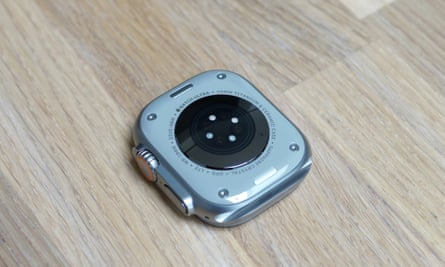For the first time in years, there’s a new top Apple smartwatch model available that’s beefier, hardier, lasts longer and is aimed squarely at dethroning Garmin at the top of the adventure watch market. But does the Apple Watch Ultra really compete? Not quite.
The new watch is not cheap, of course, and only works with an iPhone. It costs £849 ($799/A$1,299) – well above the entry point SE which starts at £259 and the Series 8 in the middle of the range costing £419 and up. That said, you can easily spend £779 on the nicest Series 8 models.
That puts high-end Ultra up against the likes of its chief rival, Garmin’s £749 Epix, but below the heady prices of £1,000-plus luxury smartwatches from Montblanc, Tag Heuer and others.
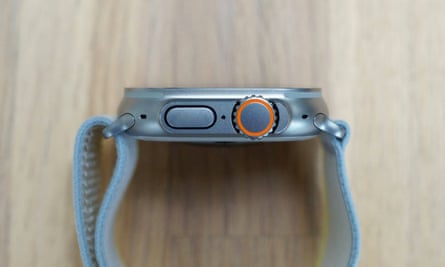
Inside the Ultra is essentially a Series 8. It has the same chip, sensors and software, which instantly makes it the most capable smartwatch on the market. But the outside is bigger, thicker, meaner-looking and made of titanium.
The flat screen is twice as bright, made of scratch-resistant sapphire glass and surrounded by a metal bezel to protect it from impact. The left side has a new “action” button and 40% louder speaker capable of producing an 86dB siren for attracting attention in the wilderness.
It looks like it means business: rugged in an expensive-looking way that’s eye-catching. Despite measuring 49mm across your wrist, the Ultra is fairly compact for an adventure watch and still easily slides under shirt cuffs. It comes with a choice of three strap types, but will take existing 44mm or 45mm Apple Watch bands, too.
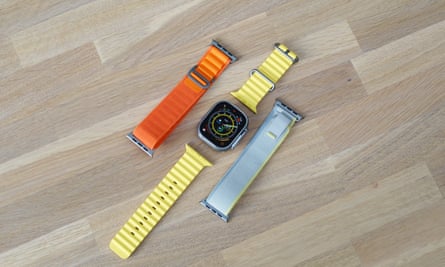
The trail loop is an improved version of Apple’s sport loop and is extremely comfortable for general wearing and running with a slight stretch. The alpine loop is a tough nylon band that resembles straps on hiking bags with a g-loop buckle. It is also very comfortable and stands out on your wrist.
The ocean band is an eye-catching, thick rubber strap designed for water sports. It has an adjustable metal strap keeper that tightly secures the free end to stop it getting caught on things.
Specifications
-
Case size: 49mm
-
Case thickness: 14.4mm
-
Weight: 61.3g
-
Processor: S8
-
Storage: 32GB
-
Operating system: WatchOS 9.1
-
Water resistance: 100 metres (10ATM)
-
Sensors: HR, ECG, spO2, temp, depth, mic, speaker, NFC, dual-band GNSS, compass, altimeter
-
Connectivity: Bluetooth 5.3, wifi n, NFC, ultra wideband, optional 4G/eSIM
Bigger battery
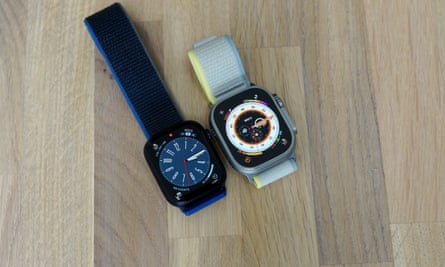
The Ultra has a 76% larger battery than other models and routinely lasts just under twice as long, at about 68 hours of continuous wearing between charges. That is two days, two nights and most of a third day, including 30 minutes of exercise a day and sleep tracking overnight. Without exercise I could squeeze three days out it.
Still, that’s under half as long as Garmin’s OLED-screen Epix and miles behind the two-week-plus Fenix 7. But compare workout tracking times and the Ultra is a lot closer. The Epix lasts about 15 hours of running tracking at its highest accuracy dual-band GPS mode or up to 42 hours with standard GPS only. The Ultra manages at least 12 hours of running in my testing with the same dual-band GPS tracking, which is certainly long enough for a marathon or 50km ultramarathon, but not quite long enough for longer 100km or 100 mile races with default settings.
A low-power mode can be enabled for workouts, which turns off the always-on screen and a few general usage alert features, extending battery life by roughly five hours. To go further, you can reduce tracking accuracy to heart rate readings once a minute and GPS readings once every two minutes instead of every second.
The Ultra charges fairly fast hitting 80% from dead in just over an hour and a full charge in just over 90 minutes using the USB-C magnetic charging puck.
Better workout tracking
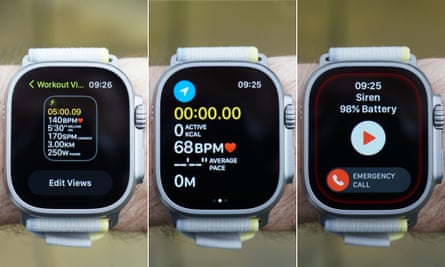
Apple has improved its workout tracking for the Ultra in a couple of ways. The screen can show six lines of metrics plus time (five on smaller models) and is extremely bright, so you can see it easily in direct sunlight. It has the aforementioned dual-band GPS technology, which increases accuracy in and around dense urban areas and generally matched rivals. The Ultra also has “precision start”, which allows you to wait to get lock on your heart rate and GPS before setting off, a software feature that should be on every Apple Watch.
There are a few missing key features compared with rivals, however. It lacks proper navigation or offline maps so you can’t load up a running or trail route leaving waypoints in the compass app or breadcrumb trails your only option to get back to the start. You can’t attach an external power meter – a common tool for endurance events. For running, you have to press the crown and action button to pause the workout, which is awkward. You also can’t set it to lock the screen automatically when working out, which means you can accidentally stop tracking or press random on-screen buttons during more strenuous activities without realising it.
None of these are deal-killers for general or occasional long-distance sportspeople, but absolutely could be for the target market of adventurers, multisport or endurance athletes.
Apple has also added a depth gauge and water temperature sensors to the watch, so that it can act as a recreational dive guide to depths of 40 metres. An app that turns it into a full dive computer to plan and log trips will be available in the near future.

Sustainability
Apple does not provide an expected lifespan for the battery but it should last in excess of 500 full charge cycles with at least 80% of its original capacity and can be replaced for £105. Any other repairs cost £509.
The Ultra contains recycled gold, plastic, rare earth elements, tin and tungsten. Apple offers trade-in and free recycling for devices, and breaks down the watch’s environmental impact in its report.
Price
The Apple Watch Ultra costs £849 ($799/A$1,299). For comparison, the Apple Watch SE costs £259, the Series 8 costs from £419, the Samsung Galaxy Watch 5 Pro costs £429, Garmin Fenix 7 costs £599 and the Garmin Epix costs £749.
Verdict
The Ultra is the biggest, best and most expensive Apple Watch you can get.
At its core it is a Series 8 turned up to 11, with a bigger battery, brighter screen, new sensors and an additional button, instantly making it the most capable smartwatch available for iPhones. Day to day its new rugged, yet expensive, look sets it apart from its siblings and makes it a statement watch. It looks great and works well.
But Apple is aiming at the adventure watch market dominated by Garmin’s high-end lines. Here the Ultra is not quite an outright winner. It is about 70% there, offering most of the features explorers and elite athletes need. But it falls short on battery for long endurance events, and lacks route mapping and compatibility with key external sensors. It is missing simple things such as in-workout button customisation and the ability to automatically lockout the touchscreen during activities. All of these are standard features on rivals.
None of these are likely to be deal-breakers for more casual or occasional athletes, but will be for those that really push the limit and rely on their sports watches. Garmin doesn’t have too much to worry about here yet, but most of the Ultra’s foibles can and probably will be solved by software additions. At which point all bets are off.
Pros: comprehensive smartwatch, health-tracking and safety features, ECG, great activity tracking, 100m water resistance, longer three-day battery life, long software support, recycled materials, optional 4G, rugged design that stands out.
Cons: very expensive, only works with an iPhone, no workout route planning or offline maps, no external sensor support beyond heart rate, battery life too short for longest common endurance events.
